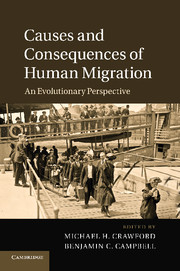Book contents
- Frontmatter
- Contents
- Contributors
- Preface
- 1 Perspectives on human migration: introduction
- Section 1 Theory
- Section 2 Geography and migration
- 8 Population structure and migration in Africa: correlations between archaeological, linguistic, and genetic data
- 9 Human migrations in North Africa
- 10 Identity, voice, community: new African immigrants to Kansas
- 11 The African colonial migration into Mexico: history and biological consequences
- 12 Demic expansion or cultural diffusion: migration and Basque origins
- 13 Consequences of migration among the Roma: immunoglobulin markers as a tool in investigating population relationships
- 14 Migration, assimilation, and admixture: genes of a Scot?
- 15 Mennonite migrations: genetic and demographic consequences
- 16 Human migratory history: through the looking-glass of genetic geography of Mycobacterium tuberculosis
- 17 Peopling the Tibetan plateau: migrants, genes, and genetic adaptations
- 18 Migration, globalization, instability, and Chinese in Peru
- 19 The great blue highway: human migration in the Pacific
- 20 Migration of pre-Hispanic and contemporary human Mexican populations
- 21 A review of the Tupi expansion in the Amazon
- 22 Molecular consequences of migration and urbanization in Peruvian Amazonia
- 23 Migration in Afro-Brazilian rural communities: crossing historical, demographic, and genetic data
- 24 Indentured migration, gene flow, and the formation of the Indo-Costa Rican population
- 25 Causes and consequences of migration to the Caribbean Islands and Central America: an evolutionary success story
- Section 3 Overview
- Index
- References
23 - Migration in Afro-Brazilian rural communities: crossing historical, demographic, and genetic data
Published online by Cambridge University Press: 05 December 2012
- Frontmatter
- Contents
- Contributors
- Preface
- 1 Perspectives on human migration: introduction
- Section 1 Theory
- Section 2 Geography and migration
- 8 Population structure and migration in Africa: correlations between archaeological, linguistic, and genetic data
- 9 Human migrations in North Africa
- 10 Identity, voice, community: new African immigrants to Kansas
- 11 The African colonial migration into Mexico: history and biological consequences
- 12 Demic expansion or cultural diffusion: migration and Basque origins
- 13 Consequences of migration among the Roma: immunoglobulin markers as a tool in investigating population relationships
- 14 Migration, assimilation, and admixture: genes of a Scot?
- 15 Mennonite migrations: genetic and demographic consequences
- 16 Human migratory history: through the looking-glass of genetic geography of Mycobacterium tuberculosis
- 17 Peopling the Tibetan plateau: migrants, genes, and genetic adaptations
- 18 Migration, globalization, instability, and Chinese in Peru
- 19 The great blue highway: human migration in the Pacific
- 20 Migration of pre-Hispanic and contemporary human Mexican populations
- 21 A review of the Tupi expansion in the Amazon
- 22 Molecular consequences of migration and urbanization in Peruvian Amazonia
- 23 Migration in Afro-Brazilian rural communities: crossing historical, demographic, and genetic data
- 24 Indentured migration, gene flow, and the formation of the Indo-Costa Rican population
- 25 Causes and consequences of migration to the Caribbean Islands and Central America: an evolutionary success story
- Section 3 Overview
- Index
- References
Summary
Introduction
In this chapter we present a general overview of the causes and consequences of migration in Brazilian Afro-derived rural communities. These communities, known in Brazil as Remanescentes de Quilombos, present some important characteristics that make them ideal models to study human migrations on a local scale, such as a distinct genetic constitution and also some degree of isolation. They were mainly formed by fugitive and freed African slaves and their descendants (Reis and Gomes, 1996). For this reason, African ancestry is predominant in their genetic composition (Bortolini et al., 1999) in contrast to other Brazilian populations, in which the European contribution is more pre-eminent (Godinho et al., 2008). Moreover, these communities were usually located at a considerable distance from urban centers, as a strategy for resisting slavery during colonial times (Reis and Gomes, 1996); nowadays, this confers them a certain degree of isolation (Souza and Culpi, 2005).
Our study seeks to relate the socioeconomic causes of the migratory behavior observed in these communities to the evolutionary consequences of gene flow at the population level, in order to understand the role of migration as an agent in the evolution of smallholder populations. We start this chapter by unraveling the history behind the first migrations of Africans to the Americas and then explain the current situation of the African descendants in Brazil, before a brief description of the communities here employed as models (Mocambo, Riacho de Sacutiaba e Sacutiaba, and Rio das Rãs). Next, there is a detailed description of the observed migratory patterns in these communities, followed by an analysis of admixture with uni- and biparental genetic markers. Finally, demographic and genetic data are crossed in order to propose new insights into the study of migrations in rural smallholder populations. We believe this might serve as a primary source for comparative studies of migration, providing guidance for assessing models of past and current human population mobility.
- Type
- Chapter
- Information
- Causes and Consequences of Human MigrationAn Evolutionary Perspective, pp. 473 - 498Publisher: Cambridge University PressPrint publication year: 2012



